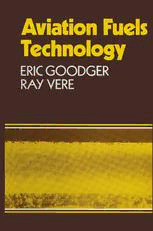
Aviation Fuels Technology PDF
Preview Aviation Fuels Technology
Aviation Fuels Technology OtherMacmillantitles ofrelated interest E.M.Goodger,AlternativeFuels E.M.Goodger,Hydrocarbon Fuels E. M.Goodger,Principlesof Engineering Thermodynamics(SecondEdition) RichardT. C.Harman,GasTurbineEngineering C.A. McAuliffe,Hydrogenand Energy Angus McDougall,Fuel Cells David Merrick,CoalCombustion and Conversion Technology Diana Schumacher,Energy --CrisisorOpportunity? Richard Stone,Introduction to Internal Combustion Engines N. Watson and M.S.Janota,Turbochargingthe InternalCombustion Engine Aviation Fuels Technology ERIC GOODGER Cranfield Institute ofTechnology Bedford and RAY VERE FormerSenior StaffScientist Esso Petroleum Co. Ltd M MACMILLAN © Eric Goodger and Ray Vere 1985 Softcover reprint of the hardcover 1st edition 1985 978-0-333-35787-3 All rights reserved. No reproduction, copy or transmission of this publication may be made without written permission. No paragraph of this publication may be reproduced, copied or transmitted save with written permission or in accordance with the provisions of the Copyright Act 1956 (as amended). Any person who does any unauthorised act in relation to this publication may be liable to criminal prosecution and civil claims for damages. First published 1985 Published by Higher and Further Education Division MACMILLAN PUBLISHERS LTD Houndmills, Basingstoke, Hampshire RG21 2XS and London Companies and representatives throughout the world British Library Cataloguing in Publication Data Goodger, Eric Aviation fuels technology. 1. Airplanes-·Fuel I. Title II. Vere, Ray 665.5'3825 TL704.7 ISBN 978-1-349-06906-4 ISBN 978-1-349-06904-0 (eBook) DOI 10.1007/978-1-349-06904-0 '...aviation fuel isasmallfactorin afield oflargeand powerful forces.Its future is at the mercy ofvarious developments: political,sociological, economicand technical.' Charles L. Blake Federal Aviation Administration U.S.A. 1982 Contents Preface xii Introduction 2 CurrentAero Engine Types 5 2.1 Engine concept development 5 2.7. Aero piston engine data 9 2.3 Aero turbine engine data II 2.4 Bibliography (chronological) 13 3 CurrentAviation Fuel Types 15 3.1 Aero piston engine fuels 15 3.2 Aviation turbine fuels 16 3.3 Bibliography 21 4 Production 22 4.1 Distillation 22 4.2 Aviationgasolines 24 4.2.1 Alkylation 25 4.2.2 Aromatics-rich blendstock 26 4.3 Aviation kerosines 27 4.3.1 Hydrocracking 28 4.4 Finishing processes 31 4.4.1 Coppersweetening 31 4.4.2 Merox sweetening 32 4.4.3 Caustic treatment 33 4.4.4 Hydrotreating 34 4.5 Storage 35 4.5.1 Aviation gasolines 36 4.5.2 Aviation turbine fuels 36 4.5.3 Tankage 36 4.6 Bibliography 38 vii S SpecificationTestMethods 39 5.1 Composition 40 5.1.1 Totalacidity 40 5.1.2 Aromatics and olefins 40 5.1.3 Total sulphur 40 5.1.4 Mercaptansulphur 41 5.1.5 Doctor test 41 5.2 Volatility 41 5.2.1 Distillation 41 5.2.2 Flash point 42 5.2.3 Vapour pressure 42 5.2.4 Density 43 5.3 Fluidity 45 5.3.1 Freezingpoint 45 5.3.2 Viscosity 46 5.4 Combustion 47 5.4.1 Knock rating 47 5.4.2 Tetraethyllead 49 5.4.3 Heat ofcombustion 49 5.4.4 Aniline-gravity product 50 5.4.5 Hydrogen content 52 5.4.6 Smoke point 52 504.7 Naphthalenes 53 5.5 Corrosion 53 5.5.1 Copper corrosionclassification 53 5.5.2 Silvercorrosion classification 54 5.6 Stability 54 5.6.1 Oxidation stability 54 5.6.2 Thermal oxidation stability 54 5.7 Contaminants 55 5.7.1 Copper content 55 5.7.2 Existent gum 55 5.7.3 Water reaction 55 5.8 Water separation characteristics 56 5.9 Electrical conductivity 56 5.10 Quality control testing 56 5.11 Bibliography 58 6 OperationalHandling S9 6.1 Distribution 59 6.1.1 Ship 59 6.1.2 Pipeline 62 6.1.3 Dedicated system 62 6.2 Equipment checks 64 6.3 Filter/separator 65 viii 6.4 Microbial activity 68 6.5 Staticelectricity 69 7 Fuel Characteristicswithin Aircraft Fuel Systems 74 7.1 Freezing point 74 7.2 Thermal stability 75 7.3 Additives 77 7.3.1 Anti-oxidants 77 7.3.2 Metaldeactivators 77 7.3.3 Compatibility 78 7.4 Stiction 78 7.5 Sulphide corrosion 79 7.6 Lubricity 80 7.7 Salt watercorrosion 82 7.8 Vapourand air release 83 7.9 Fire safety 84 7.9.1 Gelled fuels 84 7.9.2 Anti-misting fuels 85 7.9.3 Reticulated foam 86 7.10 Bibliography 87 8 Fuel CombustionPerformance 88 8.1 Mixture preparation 88 8.2 Fuel combustion in piston engines 92 8.2.1 Piston engine combustion emissions 96 8.3 Fuel combustion ingasturbine engines 98 8.3.1 Influence offuel composition on combustor performance 101 8.3.2 Fuel aromaticscontentand related properties 104 8.3.3 Fuel hydrogen content and related properties 104 8.3.4 Fuel hydrogencontent and related combustor performance 109 8.3.4.1 Flame radiation 109 8.3.4.2 Combustorliner temperature 113 8.3.4.3 Gasturbine engine combustion emissions 115 8.4 References 124 9 DevelopmentofSpecifications 127 9.1 Aviation gasolines 127 9.2 Aviation turbine fuels 130 10 RelaxationofSpecifications 136 10.1 Aviation gasolines 136 10.2 Aviation turbine fuels 137 10.2.1 Flash point 137 ix 10.2.2 Freezing point 138 10.23 Thermal stability 141 10.2.4 Combustion parameters 142 10.2.5 Volatility 143 10.3 Bibliography 144 11 Aviation Fuelsfrom AlternativeSources 145 11.1 Shale oil 148 11.2 Tar 150 11.3 Coal 152 11.3.1 Gasification plus synthesis ISS 11.3.2 Carbonisation plus hydrogenation 157 11.3.3 Hydrocarbonisation 157 11.3.4 Liquid solvent extraction plus hydrogenation 159 11.3.5 Combined liquid solvent extraction andhydrogenation 159 11.3.6 Hydrogen-donorliquid solvent extraction 159 11.3.7 Coal-derived aviation fuelpropertiesand performance 159 11.4 Resource-to-propulsion energy economy 160 11.5 References 161 12 Aviation FuelSubstitutes 164 12.1 Substitute fuel production 165 12.1.1 Liquefied hydrocarbongases 165 12.1.2 Liquid hydrogen 167 12.1.3 Hydrocarbon oxygenates 171 12.1.4 Hydrogen-nitrogen compounds 173 12.2 Propertiesofsubstitute fuels 173 123 Liquefied hydrocarbon gasesassubstitute fuels 179 12.4 Liquid hydrogen asasubstitute fuel 182 12.5 Hydrocarbon oxygenates assubstitute fuels 184 12.6 Nitrogencompoundsofhydrogen and hydrocarbons as substitute fuels 186 12.7 Resource-to-propulsionenergyeconomy 187 12.8 References 188 13 Fuels for High-Performance Flight 191 13.1 Supersonicgasturbine fuels 191 13.2 Ramjet fuels 195 13.2.1 High-density hydrocarbons 196 13.2.2 Elemental reactants 200 13.2.3 Non-carbon hydridesand metal organics 202 13.2.4 Slurry fuels 202 13.2.5 Specific impulse ofcandidate ramjet fuels 203 13.2.6 Pulsejet fuels 208 x
